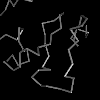?
 
PHD finger found in ubiquitin-like PHD and RING finger domain-containing protein UHRF1 and UHRF2 UHRF1 is a unique chromatin effector protein that integrates the recognition of both histone PTMs and DNA methylation. It is essential for cell proliferation and plays a critical role in the development and progression of many human carcinomas, such as laryngeal squamous cell carcinoma (LSCC), gastric cancer (GC), esophageal squamous cell carcinoma (ESCC), colorectal cancer, prostate cancer, and breast cancer. UHRF1 acts as a transcriptional repressor through its binding to histone H3 when it is unmodified at Arg2. Its overexpression in human lung fibroblasts results in downregulation of expression of the tumour suppressor pRB. It also plays a role in transcriptional repression of the cell cycle regulator p21. Moreover, UHRF1-dependent repression of transcription factors can facilitate the G1-S transition. It interacts with Tat-interacting protein of 60 kDa (TIP60) and induces degradation-independent ubiquitination of TIP60. It is also an N-methylpurine DNA glycosylase (MPG)-interacting protein that binds MPG in a p53 status-independent manner in the DNA base excision repair (BER) pathway. In addition, UHRF1 functions as an epigenetic regulator that is important for multiple aspects of epigenetic regulation, including maintenance of DNA methylation patterns and recognition of various histone modifications. UHRF2 was originally identified as a ubiquitin ligase acting as a small ubiquitin-like modifier (SUMO) E3 ligase that enhances zinc finger protein 131 (ZNF131) SUMOylation but does not enhance ZNF131 ubiquitination. It also ubiquitinates PCNP, a PEST-containing nuclear protein. Moreover, UHRF2 functions as a nuclear protein involved in cell-cycle regulation and has been implicated in tumorigenesis. It interacts with cyclins, CDKs, p53, pRB, PCNA, HDAC1, DNMTs, G9a, methylated histone H3 lysine 9, and methylated DNA. It interacts with the cyclin E-CDK2 complex, ubiquitinates cyclins D1 and E1, induces G1 arrest, and is involved in the G1/S transition regulation. Furthermore, UHRF2 is a direct transcriptional target of the transcription factor E2F-1 in the induction of apoptosis. It recruits HDAC1 and binds to methyl-CpG. UHRF2 also participates in the maturation of Hepatitis B virus (HBV) by interacting with the HBV core protein and promoting its degradation. Both UHRF1 and UHRF2 contain an N-terminal ubiquitin-like domain (UBL), a tandem Tudor domain (TTD), a plant homeodomain (PHD) finger, a SET- and RING-associated (SRA) domain, and a C-terminal RING finger. |
